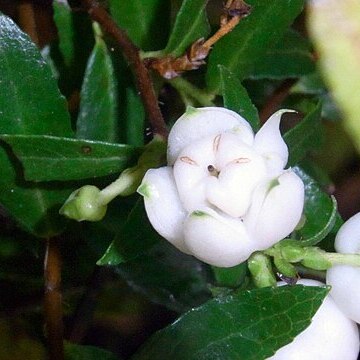Stems much-branched, ± interlacing, creeping and rooting, forming low mats seldom > 1 dm. tall; branchlets ± setose. Lvs on very short petioles; lamina coriac., elliptic to elliptic-oblong to suborbicular (the different forms sts all present on the same plant), ± 5-10-(12) × 4-6 mm., crenulate, setose on margins when young. Fls subsessile, solitary in the axils of the uppermost lvs; bracteoles 2, rounded, very small. Calyx deeply cut; lobes ovate-triangular, acute or subacute. Corolla c. 1·5 mm. long, lobes very small, obtuse, spreading to recurved. Capsule 3-4mm. diam., surrounded by enlarged, fleshy, white or red calyx.
A herb or small shrub. It is low growing and creeping. It is 10-20 cm high and spreads 30-75 cm across. The leaves are small and 1 cm long. They are rounded and dark green. The upper surface is shiny. The edges have blunt teeth and there are bristles along the edges. The leaves have short stalks. The flowers are white and bell shaped. They grow in the axils of the leaves near the ends of the stem. The fruit is a capsule with a white or red fleshy covering. They are 8-10 mm across.

